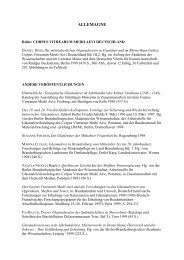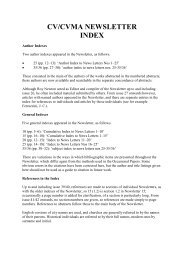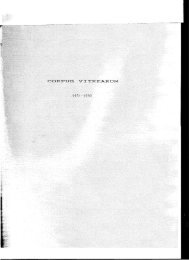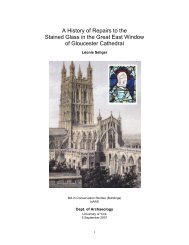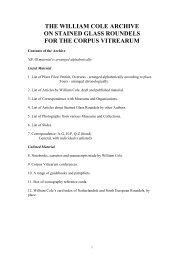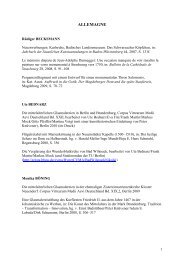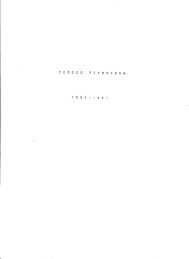BristolConference - Corpus Vitrearum Medii Aevi
BristolConference - Corpus Vitrearum Medii Aevi
BristolConference - Corpus Vitrearum Medii Aevi
Create successful ePaper yourself
Turn your PDF publications into a flip-book with our unique Google optimized e-Paper software.
Edward Compton, one of the donors, only died<br />
in 1493. Two workshops appear to have been<br />
involved, of which one has been identified as<br />
that of Richard Twygge and Thomas<br />
Woodshawe, best known as glaziers of Holy<br />
Trinity, Tattershall, Lincs. This workshop may<br />
have glazed the side windows.<br />
Iconography. The original disposition of subjects<br />
and figures in the east and side windows is a<br />
matter of some uncertainty. Marian subjects in<br />
the east window can be safely assumed and<br />
surviving fragments of inscriptions ('Sancta<br />
maria celesti lumine' and 'Sea Maria Dei geniirix,<br />
regina eeli et domina mundi') suggest that she<br />
may have been represented in a number of<br />
different guises, rather as in a window in the<br />
chapel of Browne's Hospital in Stamford<br />
(Lincolnshire) of c.1475. She may have been<br />
accompanied by virgin saints, including St<br />
Apollonia and St Agatha). There are also<br />
fragmentary figures of Benedictine abbesses.<br />
Other identifiable subjects include a Christ of<br />
Pity and a Christ of the Precious Blood.<br />
Other Medieval Glass<br />
South Transept. Vine foliage and borders,<br />
e.1340.Very similar to glass at Tewkesbury.<br />
North Transept. 14th-cquarries and borders.<br />
Nave. Borders and quarry glazing survives in a<br />
number of clerestory windows. In the north<br />
nave aisle, 15 th -cfigures of St Catherine and an<br />
archbishop (nVIII).<br />
Cloisters. In the south walk, twelve heraldic<br />
panels and round els, e.1520-25,from Prinknash<br />
Park, made for Abbot William Parker (1514-38).<br />
Installed here in 1928.<br />
Bibliography<br />
Jill Kerr, 'The East Window of Gloucester Cathedral'<br />
in T. A. Heslop and V.A. Sekules eds., Medieval Art<br />
and Architecture at Gloucester and Tewkesbury, British<br />
Archaeological Association Conference<br />
Transactions, VII, Leeds, 1985, pp. 116-129<br />
G. MeN. Rushforth, 'The Glass in the East Window<br />
of the Lady Chapel in Gloucester Cathedral',<br />
Transactions of the Bristol & Gloucestershire<br />
Archaeological Society, 44,1922, pp. 191-218.<br />
David Welander, The Stained Glass of Gloucester<br />
Cathedral, Gloucester, 1985<br />
Charles Winston, 'An Account of the Painted Glass<br />
in the East Window of Gloucester Cathedral',<br />
Archaeological Journal, 20, 1863, pp. 239-53,319-30.<br />
Sarah Brown<br />
Great Malvern Priory<br />
A small and remote place in the middle ages,<br />
Malvern owed its subsequent development to<br />
the natural springs and wells which turned it<br />
into a popular spa and holiday resort in the 18th<br />
and 19 th centuries. At its heart stands the Priory<br />
Church of St Mary the Virgin and St Michael,<br />
virtually all that remains of a minor Benedictine<br />
monastery suppressed in 1539. The building<br />
has survived because it was purchased as a<br />
replacement parish church in 1541.<br />
The Benedictine Priory was founded as an<br />
offshoot of Westminster Abbey, in 1085.<br />
However, later medieval sources, including the<br />
Founders Window (NIV) in the choir, claim a<br />
slightly earlier foundation by St Wulstan, last<br />
Anglo-Saxon Bishop of Worcester. He is<br />
supposed to have built the Priory on land<br />
granted by King Edward the Confessor, near<br />
to the site of an earlier chapel in which a hermit<br />
St Werstan, had been martyred by the Danes.<br />
In general plan and broad outlines the<br />
architecture is similar to that of Gloucester.<br />
After major rebuilding during the 15 th century<br />
it is the Perpendicular style that dominates the<br />
exterior, but, like Gloucester and Tewkesbury,<br />
remains of the earlier Romanesque church<br />
(completed c.1120) are revealed inside.<br />
THE STAINEDGLASS<br />
Malvern's forty-one windows were glazed as<br />
the rebuilding moved from east to west<br />
between about 1420 and 1485. The north<br />
transept windows followed in around<br />
30



